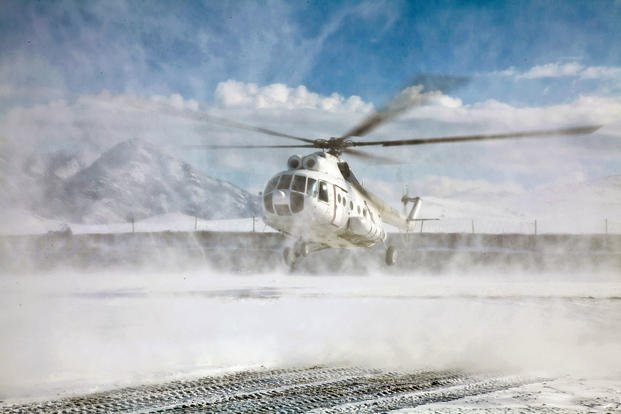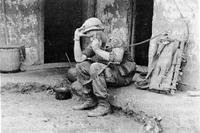For the holiday season of 2013, Forward Operating Base Shank was home. The base was situated in Afghanistan’s Logar Province, at the base of a wide topographical bowl with mountains visible in all directions—terrain that made the base a perfect target for mortar attacks. In the warmer months, attacks were constant, earning Shank the nickname “Rocket City.” In the winter, things were quieter. The Taliban, like everyone else, stayed inside to avoid the cold.
The holidays during a deployment can stir up all kinds of emotions. There’s the loneliness that comes from missing family and friends. There’s also the inherent hopefulness of the season, which, depending on the location, can feel bizarrely out of sync with your surroundings. Cheesy attempts abound to make bases and outposts “like home”—holiday lights, Santa hats, and more pies than you can shake a 122-millimeter rocket at.
Read More: Care Packages Are Not Kindling for Burn Pits
The season also meant an incoming barrage of care packages from the United States. Arriving by helicopter with our usual mail, these were dozens, if not hundreds, of identically shaped USPS boxes, filled to the brim with all manner of snacks, sweets, and supplies, courtesy of some church, elementary school, or civic group somewhere. It was, it seemed, how strangers showed they cared: a bit of candy and holiday cheer to support the troops, as one must in America.
But where did all that loot wind up?
The trash, mostly.
Or the burn pit.
The thing is, by that time, most service members wanted for very little in Afghanistan. Fully 12 years on from America’s invasion of the country in 2001, the supply chain was such that most bases were replete with indulgences: all the granola bars, candy, and off-brand energy drinks one could ever need. My personal staples included clementine oranges, single-serving packets of peanut butter, and Fanta. It was not uncommon for some people, at least those who seldom left base, to gain weight while technically at war.
So, the problem with most care packages—let’s exclude ones from family members, which were more personal in nature—was that we, the troops, were perfectly well cared for as it was. Sure, there were remote outposts where soldiers and Marines still scraped by on MREs. But if those folks weren’t getting a regular and respectable supply of food, they certainly weren’t getting the bulk of those care packages.
Back in the land of plenty, we pecked and nibbled from the boxes—but mostly as a matter of convenience, to save a short walk to a dining facility.
Many packages included handwritten notes calling us “heroes” and thanking us for “protecting America’s freedom.” These, to many of us, rang hollow. In 2013, whatever connection had existed between the war and our country’s well-being was blurry at best. The notes begged the question: What, really, did Americans imagine we were doing over there?
Then there were the bad care packages, the ones loaded with boring dry goods, like oatmeal, and obviously leftover Halloween candy (fun-size Milky Way bars not being a traditional Yuletide treat). I remember one box that was filled entirely with peppermints. Others contained supplies that were useful in theory, like body wash and socks. But we had plenty of those already, too. And frankly socks for Christmas in Afghanistan are still just socks for Christmas.
To me, the care packages were a powerful symbol of how out of touch most Americans were—and remain—with our Post-9/11 wars. Enormous sums have been spent making our military all-too-comfortable down range. Where many Americans imagine impossible hardship, wartime dining facilities feature steak and lobster nights, ice cream machines, and flat-screen TVs. Infamously, a base in Kandahar province had a TGI Fridays restaurant, until it was shut down in mid-2013—a Kentucky Fried Chicken, too.
The mission, meanwhile, stumbled through the years, without clear strategy.
Indeed, morale and welfare spending is good for a laugh, but I don’t regard it as necessarily wasteful; it’s a drop in the bucket of the more than $2 trillion the United States will spend in Afghanistan, only for the Taliban to be stronger in 2020 than it has been in years and for al-Qaida to have a resilient and possibly growing presence in the region. Neither am I completely down on care packages; it’s the thought that counts, after all. But feel-good gestures can only go so far if they’re not paired with a more earnest investment in the fate and implications of America’s wars.
What the troops really needed from the American public was interest in what was going on in Afghanistan. The failures of our efforts, which are many and well-recounted elsewhere, had been evident to service members for a long time. That America persisted, knowing our strategies were mostly ineffective, amounted to negligence, and it resulted not only in troop deaths but in a bad hit to America’s credibility abroad and, crucially, untold human tragedy for the Afghan people. With limited public pressure to do better, however, there was little imperative for politicians and military leaders to change. We needed people to be angry—for people, to put this as simply as possible, to actually care.
Instead—tragically, comically, and flown across the world at no small cost in jet fuel—we got warm wishes packed into boxes of candy we already had.
To be certain, I’m not the only Grinch. “We got the s----iest care packages,” said one friend, a Marine, who was in Kandahar that same winter. “A bunch of hygiene kits, with, like, 99-cent toothbrushes, the kinds where the bristles are all the same length.”
“I couldn’t believe the time and effort people put into those boxes,” said another friend, who was with me in Logar. “Imagine if that had gone towards people who really needed it, like the homeless. But I guess it’s more romantic to imagine you’re doing your part for America.”
And so, in the end, most care packages enjoyed the fate of holiday cards from distant relatives. They meant well, so we would have felt guilty getting rid of them right away. But by the time January or February rolled around, they were clutter. Nobody thought twice when, one day, they were all thrown out.
Editors Note: This article first appeared on The War Horse, an award-winning nonprofit news organization educating the public on military service. Subscribe to their newsletter















